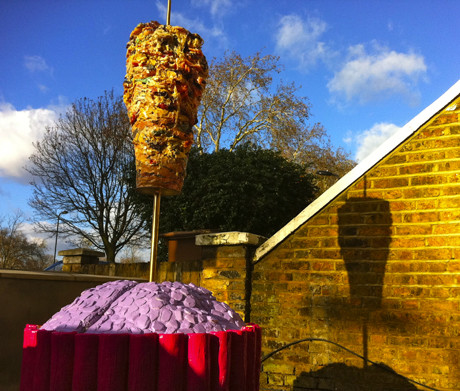Patio Projects – art in the public eye

WW Gallery's public art project brings art onto the street
This month Stephanie Wehowski’s white tower of mushrooms, Stupa, marks the end of the WW Gallery’s year-long showcase and experiment with public art, the Patio Projects.
Last year the projects began with Eva Lis’ Mudman just as the London Riots were breaking out across the park and in the neighbouring estate. But the overriding message has been of the strength of locality, connections and conversations.
Patio Project #13, Stupa, is simultaneously supernatural and organic – the perfect dichotomy for a summation of the Patio Projects, which have offered residents extremes of both the hauntingly familiar and the strikingly bizarre.
This dichotomy has certainly made the Projects a talking point, whether it’s the echo of the local birds flitting about Hackney Downs park (the duplicitous magpies in Kate Davis and David Moore’s Pica Pica and the many hundreds of mummified pigeons in Delores De Sade’s The Form of a Thing is the Outcome of all it Endures), or such delights as the gruesome saccharine display of Flora Parrott’s sugar fingers and Lucy May’s kitsch wax kebab.
A neighbour of the Patio Projects, Ben Spaull, commented: “I’ve lived above Patio Projects for a little over a year now and feel saddened to no longer have the chance to advise visitors to “turn left at the pub, and walk straight ahead until you reach the mudman / teepee / giant kebab”. Patio Projects never failed to inspire conversation among my house guests, but also from curious passersby. I guess the neighbourhood will just have to find something else to talk about now.”
Some of the neighbours have got involved in the projects throughout; Otto the ginger cat has continued to spread his mischief, unravelling Evy Jokhova’s Stringscape and spreading his plastered paw-prints out onto the street from Hanae Utamura’s CONSTRUCT.
Mike, of second hand shop Ries Wools on Clarence Road, has become something of a seasoned art critic, and many of the Patio Projects artists have anecdotes about his creative suggestions. He explained: “I like seeing what the artists are doing, and I like to make suggestions to help them improve it.”
The Patio Projects have represented a localised social history and have been a frequently surreal documentation of a Hackney neighbourhood.
The Three Sisters pub at the end of the road has hosted the overspill from all of the cold and wet private views, and has offered an equal refuge for artists enduring the weather as they install their projects.
The Projects have been best when they do more than just let the neighbours in, when they have reflected and absorbed the very atmosphere of the locality.
Kirsty Tinkler’s Face/Off and Jokhova’s Stringscape were both inspired by the rich architectural legacy of the East End of London, and were different kinds of patchworks of the urban landscape facing and surrounding them. These public art works came to belong to the place, to the street, and so it is fitting that at the end of the month they were taken apart and destroyed.
The Projects have certainly brought the community together in unusual ways and that is rare in a world where we frequently find a restrictive formula for how art should be experienced. Four year old Lila was sad to see the giant doner kebab go, but then there were Penny Sadubin’s bluebells to be planted in the torrential rain, bringing mud and joy to other children. One anonymous passerby commented that, “If I knew this sort of thing was in art galleries, I would probably go more.”
Directors of WW, Debra Wilson and Chiara Williams, sometimes found it difficult to convince residents to attend private views when the gallery was tucked away inside the flat, but bringing the art out onto the street has made it a little harder to avoid.
Every First Thursday over the year of the projects, a crowd has gathered on the street beside the patio, come rain or shine. This crowd has been just as likely to include disinterested residents as artists and gallerists.
The projects have each spoken to different people in different ways: Jokhova remembers the electricians who mistook her Stringscape for the telephone exchange, and Andy Wicks recalls that his own Project, Beached, a recreation of an industrial mooring structure found alongside the banks of the Thames, was transformed by the public’s imaginations into a giant easel.
That’s the beauty of public art: there is no hand-out to dictate the deeper meaning, no gallery assistant to correct your assumptions. You can stop on the street to consider it for as long as you like, or judge it as you pass out of the corner of your eye.
Stupa is at 30 Queensdown Road and viewable until 31 December.
